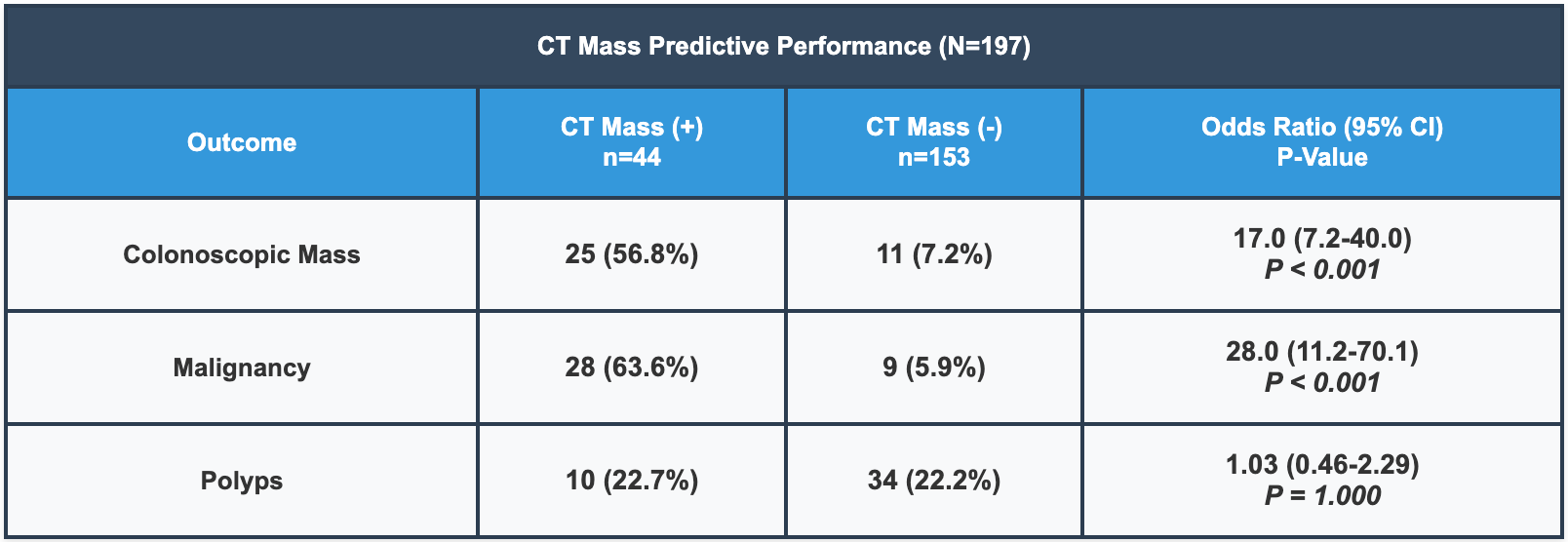Sunday Poster Session
Category: Colon
P0271 - Predictive Value of CT-Detected Masses for Colonoscopic Mass Detection and Biopsy-Proven Malignancy: A Retrospective Single-Center Analysis

Mohsin Chundrigar, MBBS (he/him/his)
Albany Medical Center
Albany, NY
Presenting Author(s)
1Albany Medical Center, Albany, NY; 2Aga Khan University, Karachi, Sindh, Pakistan
Introduction:
Patients with gastrointestinal symptoms often undergo abdominal computed tomography (CT) imaging, revealing masses that prompt colonoscopy evaluation. However, the predictive value of masses on standard abdominal CT for confirming colonoscopic findings is not well established. This study assessed the association and predictive performance of CT for detecting masses during subsequent colonoscopy and biopsy-proven malignancy.
Methods:
We conducted a retrospective single-center study of 197 adult patients who underwent colonoscopy following abdominal CT imaging for various GI symptoms. CT and colonoscopy reports were reviewed for masses and polyps. Pathology reports were reviewed to confirm malignancy diagnosis. Statistical analysis included logistic regression, Chi-square testing, and ROC analysis with odds ratios (OR) and 95% confidence intervals (CI).
Results:
Among 197 patients, 55% were female with mean age 57.6 years (SD 17.4). CT-detected masses were identified in 44 patients (22.3%) and colonoscopic masses in 36 patients (18.3%). Among those with CT-detected masses, 25 of 44 (56.8%) had colonoscopic confirmation compared to 11 of 153 (7.2%) without CT masses (P < 0.001). Logistic regression demonstrated CT masses strongly predicted endoscopic detection (OR 17.0, 95% CI 7.2–40.0, P < 0.001), with area under ROC curve of 0.79. Sensitivity, specificity, PPV, and NPV were 69.4%, 88.2%, 56.8%, and 92.8%, respectively.
Discordant findings occurred in 19 patients (43.2%) with CT-detected masses but no colonoscopic mass, and 11 patients (30.6%) with colonoscopic masses but no CT-detected mass. Among CT mass patients, malignancy was confirmed in 28 of 44 cases (63.6%) compared to 9 of 153 (5.9%) without CT masses (OR 28.0, 95% CI 11.2–70.1, P < 0.001). Polyp detection showed no association (22.7% vs 22.2%, P = 1.000).
Discussion:
CT-detected masses strongly predict colonoscopic masses and biopsy-proven malignancy but not polyps. While CT colonography demonstrates sensitivity and specificity exceeding 90% for colorectal masses standard abdominal CT yields moderate predictive performance with good specificity but limited sensitivity. These findings support prioritizing colonoscopy for patients with radiographic masses, particularly for malignancy risk stratification, while recognizing that negative CT imaging does not exclude significant colonoscopic findings.
Figure: Comparison of colonoscopic findings between patients with and without CT-detected masses.
Figure: Diagnostic performance metrics of CT-detected masses for predicting colonoscopic mass detection.
Disclosures:
Mohsin Chundrigar indicated no relevant financial relationships.
Osama Alshakhatreh indicated no relevant financial relationships.
Shamayel Safdar indicated no relevant financial relationships.
Jad Moumen indicated no relevant financial relationships.
Ibrahim Mohammed indicated no relevant financial relationships.
Sarim Ansari indicated no relevant financial relationships.
Shahreen Ansari indicated no relevant financial relationships.
Khaled Elsokary indicated no relevant financial relationships.
Sheraz Hakeem indicated no relevant financial relationships.
Seth Richter indicated no relevant financial relationships.
Mohsin Chundrigar, MBBS1, Osama Alshakhatreh, MD1, Shamayel Safdar, MBBS1, Jad Moumen, MD1, Ibrahim Mohammed, MD1, Sarim Ansari, MBBS1, Shahreen Ansari, MBBS1, Khaled Elsokary, DO1, Sheraz Hakeem, MD2, Seth Richter, MD, FACG1. P0271 - Predictive Value of CT-Detected Masses for Colonoscopic Mass Detection and Biopsy-Proven Malignancy: A Retrospective Single-Center Analysis, ACG 2025 Annual Scientific Meeting Abstracts. Phoenix, AZ: American College of Gastroenterology.
